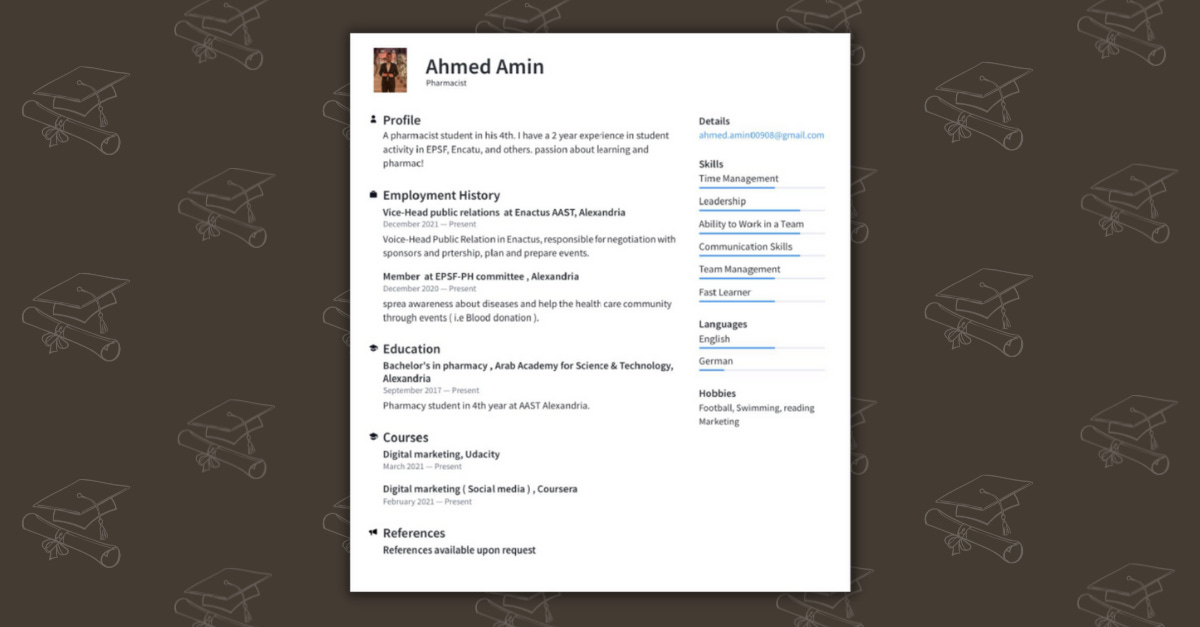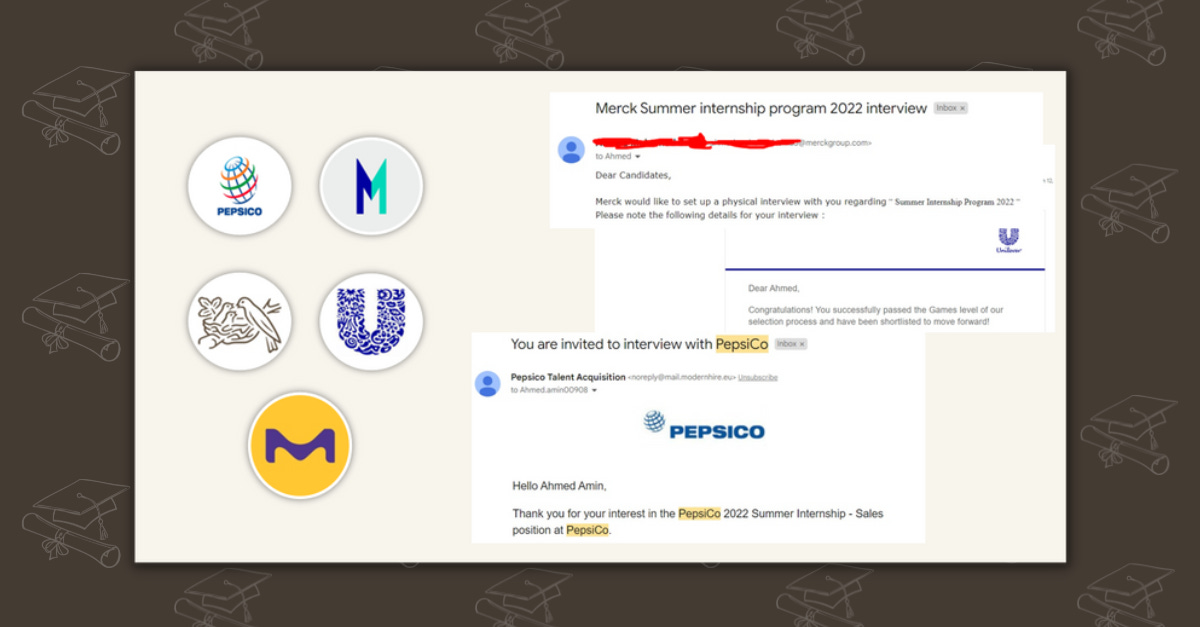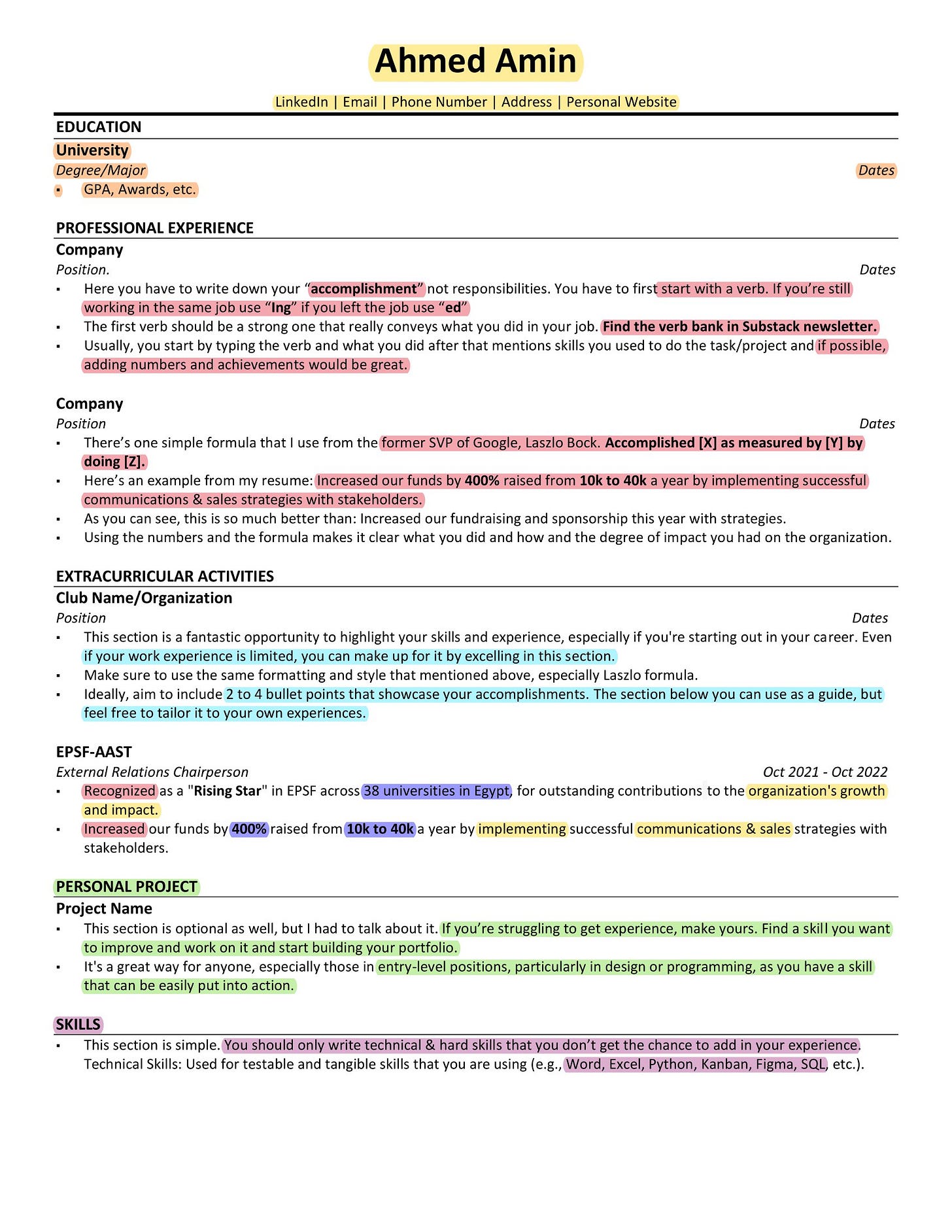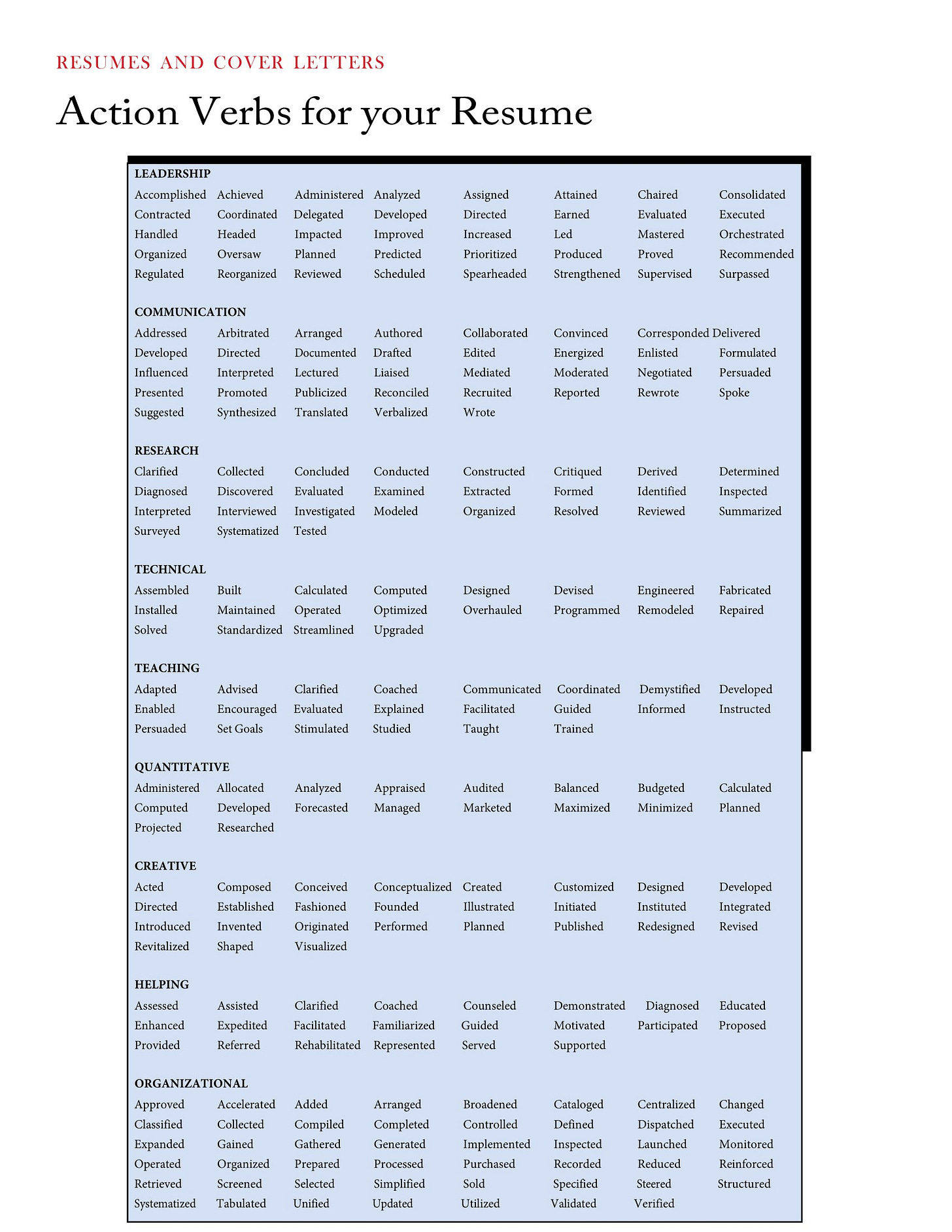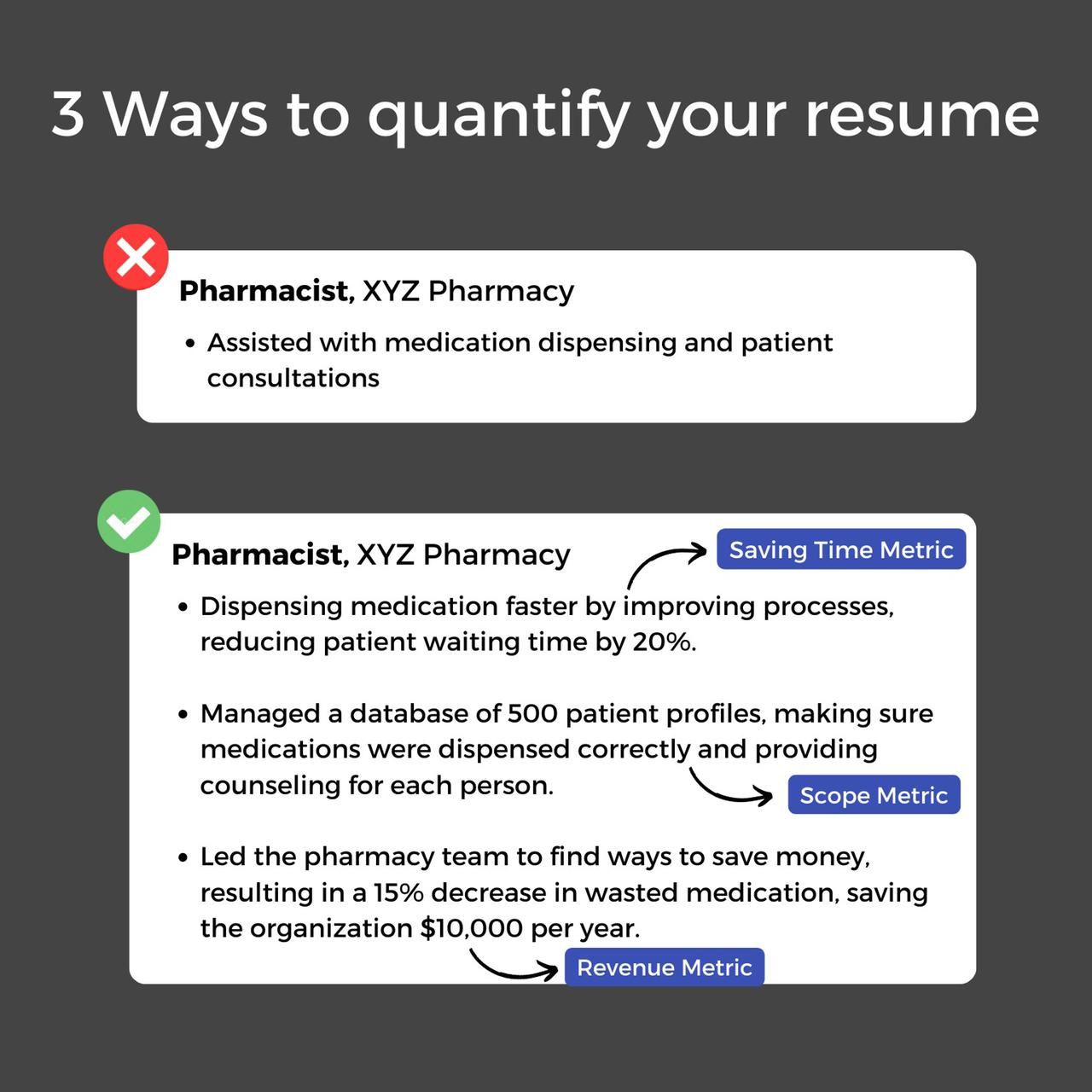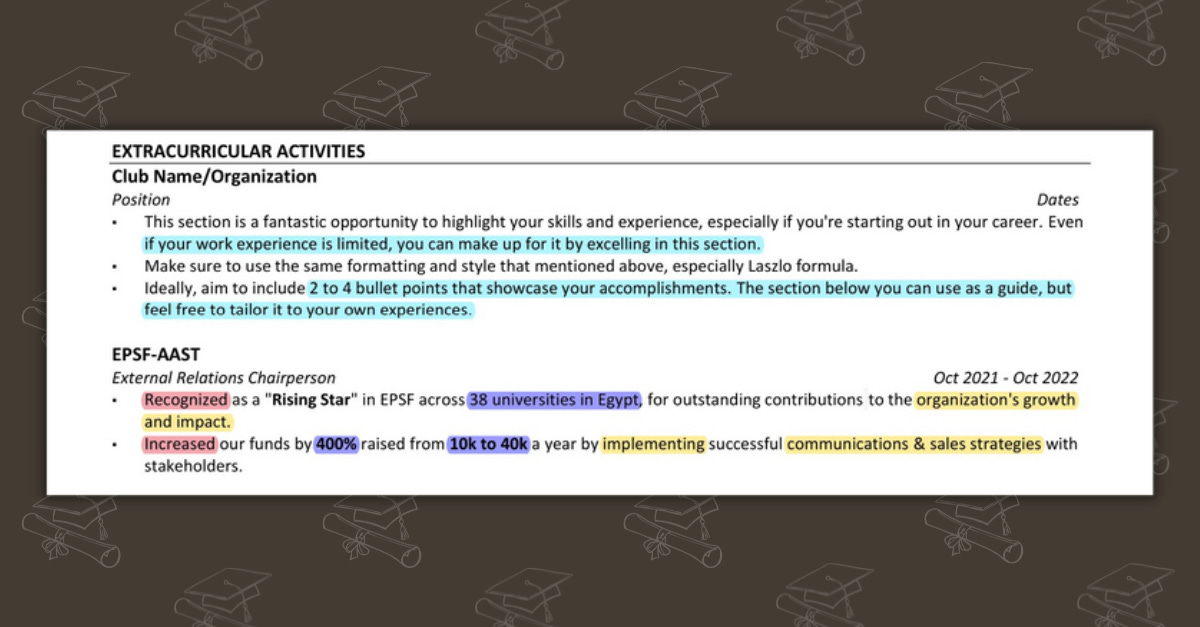How I made a resume that got me interviews in college. (And how you can do the same)
All things resume, misconceptions, step-by-step breakdown, and resume template.
One of the things that we don’t get to learn in school is how to make a good resume.
It’s one of these skills that you have to pick on your own. I realized that late while I was in college.
Throughout the first three years of my college, I dedicated a lot of time and effort to applying for internships and jobs, but unfortunately, I didn't have much success. The number of interviews I managed to secure was significantly lower than anything I had encountered before.
I couldn't figure out what I was doing wrong. Despite having volunteering experience, completed courses, and being halfway through my bachelor's degree, a great GPA, I still wasn't receiving any callbacks for interviews.
To give some context, I'm referring to the very first resume I created.
It took me three years of trial and error to make a resume that get results. I dedicated my time to testing and researching various approaches because, whether I liked it or not, my career depended on it. What I didn't realize initially was that there is a science behind crafting a resume.
The summer after that year, I started to apply again and to my surprise, I got interviews —A lot of them. In that year alone I had 6 interviews with companies like Nestle, Unilever, PepsiCo, Eva Pharma, and Merck.
You don’t have to go through all the things I did to reach where my resume at now because this newsletter will be the only guide you need if you’re in college or just graduated.
This will be long but I promise will be worth it. But before talking about how you approach your resume, let’s talk about misconceptions that I had to learn the hard way in the process of iterating and working on my resume.
Misconceptions
Your resume isn’t everything.
Once I started receiving interviews, I believed that I had cracked the code. I thought that from then on, for every job I applied to, I would at least make it to the interview stage.
I couldn't have been more wrong.
The truth is, there are countless reasons why you may not progress to the interview stage:
You might not be the right fit for the company.
Your resume could get lost in the overwhelming stack of thousands of applicants.
There may be stronger candidates who advance to the next stage.
These are just a few examples among many.
My point is you’ve to spend effort and time working on your resume but don’t stress about it. In most cases, you only need a few tweaks and changes to have a good resume that works (We will talk about them later on).
There’s no one size fit.
The talk about resumes can go endlessly and almost everyone has an opinion about it from HRs to everyone (including me lol) but what I found is that in its simplest form resume are made to convey your value to the recruiters and hiring managers.
So make whatever is necessary to show that in your resume.
If you excel in sports and have achieved national-level recognition and numerous awards, make sure to include that information and highlight it.
If you're an international student with proficiency in three or four languages, emphasize those language skills in your resume.
These skills are not only rare but also demonstrate qualities such as commitment, self-learning, and more. They can be your ticket to landing your dream job, so leverage your strengths in your resume.
Just find what your unique advantage and use it
Step-by-step on how to write a great resume (From my experience)
Let’s take a look at the template that I used.
In the resume, I emphasized each section and its components. Without further ado, let's dive right in.
Your information.
This is the first thing you see in any resume so don’t mess it up. It's important to keep it simple and avoid including unnecessary personal details such as religion, race, or birthday. Here are what you should write:
Your Name: Make sure your name is bold and clear, placed at the top of the resume so that it is easily identifiable as yours.
LinkedIn: If you include your LinkedIn profile, ensure that it is updated, clean, and tailored to your job role.
Email: Use your personal email address instead of your college or work email. Make sure your email address is professional and includes your real name.
Example:
Phone Number: If you're applying for a job outside your country, don't forget to include the country code before your phone number.
Address: Many people make mistakes with this section. If you're applying for a local job or a position in another region, only mention the state/region you're in. You don't need to include your street name or building number.
Personal Website: If you have a personal website, it can act as an extension of your resume. Include it if you have one.
Note: Some websites, such as Behance and Github, can serve as portfolios. If you have such a website, definitely add it to your resume.
Education
The education section pretty much has only your major, GPA, Awards, and in some cases coursework.
GPA: It’s a good rule of thumb if your GPA is above 3.5 to add to your resume. If it from 3.0 to 3.4 it can be questionable and may vary depending on your industry. Research and test the within your specific field to determine what work and what not. Remember, your GPA is one indicator of success that not many companies use it to judge your qualification. So, if you find yourself lacking in GPA, don’t stress it out and try to make it up with experience.
Awards: Adding awards to your education section is optional but can significantly increase your chances and credibility. The source of the award doesn't matter; whether it's from a professor, a club, or your college dean, it adds value to your profile.
Coursework: The relevance of including coursework varies across countries and industries. In some countries, like Egypt where I live, it’s not relevant. In other countries, hiring managers and recruiters may be interested in seeing relevant coursework. If it’s relevant, check the skills and requirements in the job description of the job and add the coursework that is relevant to the role.
Experience section
This one was the worst section, I had on my resume. Because any type of work experience requires experience to get accepted so where should I gain it?
The most obvious route is through internships, but even those often require prior experience. To help address this issue, I have created a mini-guide that outlines 10 ways to gain experience in college other than interning. Check it out here.
If you’re still thinking of ways to break that cycle, see the next two sections.
When it comes to writing your experience, there is a lot of complex advice out there. However, as a student, you don't need to go to that far. The guidelines I’ll discuses here are basic yet crucial. If you get those right, your resume will be well-positioned for a long time.
The first thing you need to write your experience is to start with a verb that conveys what you did. Here’s a verbs bank from the Harvard Career Guide.
The idea behind your experience sections is to show how impactful and valuable your skills are. You want to impress the recruiter and show that you’re the one that solves their problems. But how to do so in just a short sentence?
One piece of advice I found hopeful was from Laszlo Bock, former SVP of Google. He wrote a mini guide about his winning formula to write impressive bullet points, which you can find here. His formula was:
Accomplished [X] as measured by [Y] by doing [Z]
Here are two examples from before and after I apply his advice.
Increased our fundraising and sponsorship this year with strategies.
Increased our funds by 400% raised from 10k to 40k a year by implementing successful communications & sales strategies with stakeholders.
As you can see, the letter not only shows how much impact I made which is 400% increase but also highlights the approach I took to achieve them. While there is room for further specification, it remains a valuable experience to include on a resume.
It's important to note that you can incorporate numbers into your resume, even as a student. You don’t need years to write down numbers on your resume.
For example, you can write your numbers and quantify them based on:
Increase & decrease in (Sales, awareness, blogs, etc.).
Time (Waiting time, time to process, time to finish a take or a project).
Scope (The number of members in your project, the number of projects).
Leadership/Volunteering experience.
This section and the next one are optional, depending on your strengths and where you can showcase your skills. For me, this section proved to be instrumental in breaking free from the cycle of needing prior experience.
I had worked two years as a volunteer in my college clubs and the experience I gained was unparalleled. I didn’t think I could learn so much just from a club.
At one point, I took on the responsibility of managing over 9 cross-functional teams and coordinating the +100 students. This is one of the advantages of student clubs that you can’t get anywhere else —Leadership experience.
Depending on how much time and effort you invest, you could secure most internships by nailing this section down. The bullet points in this section follow the same structure as before, using the Laszlo formula.
To illustrate, let's break down two bullet points from my resume:
Red Color: Action verbs. Notice that I used the past tense (-ed) at the end of each verb to indicate that these actions occurred in the past.
Blue Color: Quantifying each bullet point. In the first example, I used "Scope" to indicate the number of universities involved. In the second example, I highlighted the increased percentage and provided specific numbers to demonstrate the impact after I assumed the responsibility.
Yellow Color: Adding soft and hard skills, as well as action words, to align with the specific job description of the role you're applying for.
Note: If you have experience with specific technologies or tools such as Figma, Photoshop, Java, etc., include them within the yellow section to help you pass the ATS and give credibility to your resume.
Personal Projects
This is one that depends on you. If you’re feeling that you can’t get experience anywhere. Create your own.
For example, if you're majoring in programming, consider building a website and showcasing your work there.
If you're pursuing a design major, start creating designs for local stores or brands you admire, and include them in your portfolio.
The same goes for anything. No one will get out of his way to give you a chance.
P.S. The structure and layout for this section should follow the same guidelines as the previous sections. Use action verbs, quantify your achievements, and highlight relevant skills to align with the job description.
The Skill Section
The skills section is straightforward and should include only the testable and tangible skills that you excel at and that are specifically mentioned in the job description.
The more closely your skills match the requirements of the position, the better. This increases the chances of your resume passing through Applicant Tracking Systems and progressing to the next stage of the hiring process.
Final Note + Template
Remember that your resume is just one part of your job search. There’re other factors and parts that you need to work on such as your interviews, networking, etc. While applying all of these tips would increase your chances to get interviews, it’s still up to your experience to make the final call and get you that interview.
Always ask yourself after each rejection, was it my experience or my resume? My approach changed when I realized I lack both. Find what what you lack and work on it and always have trust on your skills and experience. Again, You can check this guide about other ways to get experience other than interning here.
Finally, you can get the resume template from here.
In the end, the best way to make your resume is by trial and error. Create a resume with these tips, apply for jobs, get feedback, and iterate and you’ll reach there.
That’s it! Thank you for sticking to the end. 👋
Sincerely,
Ahmed Amin
If you enjoyed this newsletter, make sure to share it with your friends or colleagues. It takes only 30 seconds to do so.
We pour a lot of time and effort into creating this content for you, and your support means the world to us.



